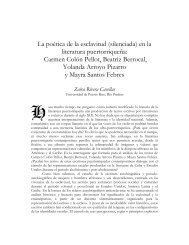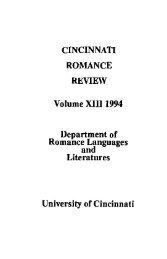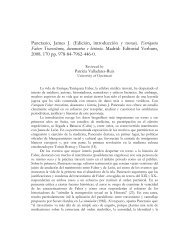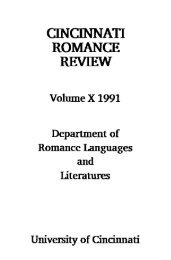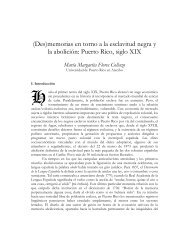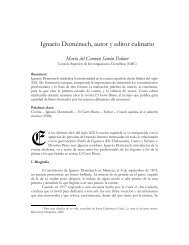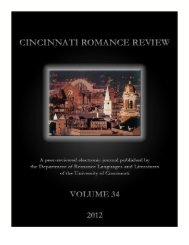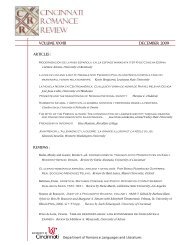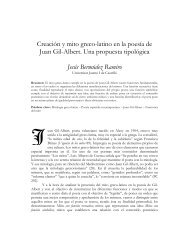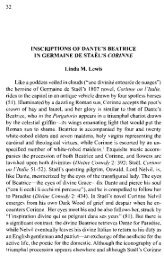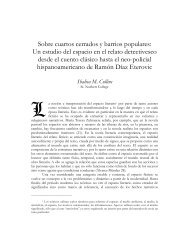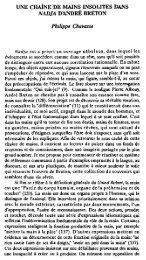Volume 30 (2011) - Cincinnati Romance Review
Volume 30 (2011) - Cincinnati Romance Review
Volume 30 (2011) - Cincinnati Romance Review
You also want an ePaper? Increase the reach of your titles
YUMPU automatically turns print PDFs into web optimized ePapers that Google loves.
176<br />
GALADRIEL MEHERA GERARDO<br />
Mexicans had no hope of arguing for decent standing (let alone supremacy), descended<br />
largely from one of the European groups deemed less evolved and two of the groups at<br />
the bottom of the hierarchy. Furthermore, attempts at encouraging European<br />
immigrants had proven unsuccessful and despite the anti-Indian policies of the Porfiriato<br />
indigenous and mixed race people continued to comprise the majority of Mexico’s<br />
population. This realization as well as the nationalism inspired by the Mexican<br />
revolution gave birth to a new understanding of who would be included in and<br />
embraced by the Mexican nation. Rather than accepting the intellectual musings of their<br />
neo-colonial oppressors as the Porfirian positivists had and forever relegating the vast<br />
majority of Mexicans--and by extension the nation of Mexico itself--to an inferior<br />
position, following the revolution Mexican nationalist intellectuals (in classic anticolonial<br />
fashion) used the tools of the oppressor to liberate themselves. They attempted<br />
to turn arguments for Anglo supremacy on their heads by using the same pseudoscience<br />
that had allowed Spencer to “prove” Anglo-Saxon supremacy, instead arguing<br />
that Mexico’s unique racial makeup predetermined the nation’s strength (Minna Stern,<br />
190-191).<br />
Other Latin American intellectuals responded to Eurocentric racial pseudoscience<br />
in ways that mirrored the Revolutionary and post-revolutionary Mexican<br />
intelligentsia. The intellectual leader of the Cuban revolutionary war for independence,<br />
Jose Marti, also argued that the mixed race and multi-racial populations of the island<br />
offered the possibility for a stronger nation than the United States and European<br />
nations. In the mid 20th century, the Brazilian social scientist Gilberto Freyre argued<br />
that Brazil’s large population of people of African descent suggested a stronger future<br />
than the segregated, Anglo-dominated population of the U.S., which he argued would<br />
always have a “negro problem” (Graham 166).<br />
The nationalist ideologies of Marti and Freyre had more in common with those<br />
of the Mexican intelligentsia than simply responding to a Euro-American racial<br />
hierarchy that destined their populations to secondary standing, however. While<br />
attempting to invert Euro-American racism, late 19th and early to mid 20th century<br />
Latin American intellectuals in general and the Mexican intelligentsia in particular<br />
inadvertently reified many of the racist North Atlantic precepts that they sought to<br />
counter. The most obvious—and most discussed—manner in which the Mexican<br />
intelligentsia did so was to argue for racial mixing as a means of eliminating segregated<br />
indigenous populations, who they believed exhibited characteristics of racial inferiority. 3<br />
Less obvious but nonetheless significant was their tacit approval of the North Atlantic<br />
assertion of African racial inferiority by ignoring African heritage in their own country.<br />
Early to mid 20 th century Latin American intellectuals attempted to reject<br />
European and U.S. ideas about race in an effort to champion the merits of their own<br />
people. But at their base these new racial ideologies were flawed both because they<br />
3 See Minna Stern (190), for example.<br />
<strong>Cincinnati</strong> <strong>Romance</strong> <strong>Review</strong> <strong>30</strong> (Winter <strong>2011</strong>): 172-183.



